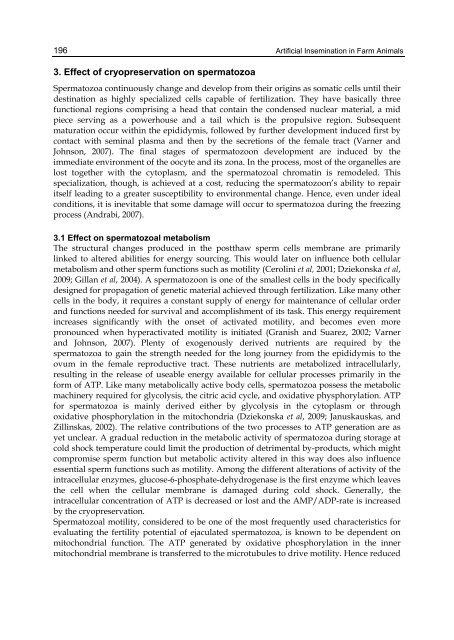ARTIFICIAL INSEMINATION IN FARM ANIMALS - Phenix-Vet
ARTIFICIAL INSEMINATION IN FARM ANIMALS - Phenix-Vet
ARTIFICIAL INSEMINATION IN FARM ANIMALS - Phenix-Vet
Create successful ePaper yourself
Turn your PDF publications into a flip-book with our unique Google optimized e-Paper software.
196Artificial Insemination in Farm Animals3. Effect of cryopreservation on spermatozoaSpermatozoa continuously change and develop from their origins as somatic cells until theirdestination as highly specialized cells capable of fertilization. They have basically threefunctional regions comprising a head that contain the condensed nuclear material, a midpiece serving as a powerhouse and a tail which is the propulsive region. Subsequentmaturation occur within the epididymis, followed by further development induced first bycontact with seminal plasma and then by the secretions of the female tract (Varner andJohnson, 2007). The final stages of spermatozoon development are induced by theimmediate environment of the oocyte and its zona. In the process, most of the organelles arelost together with the cytoplasm, and the spermatozoal chromatin is remodeled. Thisspecialization, though, is achieved at a cost, reducing the spermatozoon’s ability to repairitself leading to a greater susceptibility to environmental change. Hence, even under idealconditions, it is inevitable that some damage will occur to spermatozoa during the freezingprocess (Andrabi, 2007).3.1 Effect on spermatozoal metabolismThe structural changes produced in the postthaw sperm cells membrane are primarilylinked to altered abilities for energy sourcing. This would later on influence both cellularmetabolism and other sperm functions such as motility (Cerolini et al, 2001; Dziekonska et al,2009; Gillan et al, 2004). A spermatozoon is one of the smallest cells in the body specificallydesigned for propagation of genetic material achieved through fertilization. Like many othercells in the body, it requires a constant supply of energy for maintenance of cellular orderand functions needed for survival and accomplishment of its task. This energy requirementincreases significantly with the onset of activated motility, and becomes even morepronounced when hyperactivated motility is initiated (Granish and Suarez, 2002; Varnerand Johnson, 2007). Plenty of exogenously derived nutrients are required by thespermatozoa to gain the strength needed for the long journey from the epididymis to theovum in the female reproductive tract. These nutrients are metabolized intracellularly,resulting in the release of useable energy available for cellular processes primarily in theform of ATP. Like many metabolically active body cells, spermatozoa possess the metabolicmachinery required for glycolysis, the citric acid cycle, and oxidative physphorylation. ATPfor spermatozoa is mainly derived either by glycolysis in the cytoplasm or throughoxidative phosphorylation in the mitochondria (Dziekonska et al, 2009; Januskauskas, andZillinskas, 2002). The relative contributions of the two processes to ATP generation are asyet unclear. A gradual reduction in the metabolic activity of spermatozoa during storage atcold shock temperature could limit the production of detrimental by-products, which mightcompromise sperm function but metabolic activity altered in this way does also influenceessential sperm functions such as motility. Among the different alterations of activity of theintracellular enzymes, glucose-6-phosphate-dehydrogenase is the first enzyme which leavesthe cell when the cellular membrane is damaged during cold shock. Generally, theintracellular concentration of ATP is decreased or lost and the AMP/ADP-rate is increasedby the cryopreservation.Spermatozoal motility, considered to be one of the most frequently used characteristics forevaluating the fertility potential of ejaculated spermatozoa, is known to be dependent onmitochondrial function. The ATP generated by oxidative phosphorylation in the innermitochondrial membrane is transferred to the microtubules to drive motility. Hence reduced










